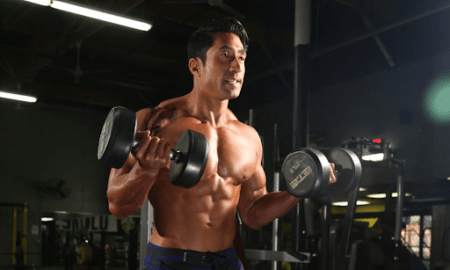


Q: Every time I see photos of you, I’m amazed at the size and shape of your biceps and triceps. Do you have any arm-training secrets for us mere mortals?
A: Thanks for your kind words. I have to say that I’m usually amazed as well when I see photos of my arms—especially when IRON MAN’s Michael Neveux is the photographer! My perception of my arms is that they’re not as big as they look in the photos. So secret number one is, shoot with Mike.
Over the years I’ve had quite a number of men with many years of lifting experience come to me and tell me that they do a great volume of hard training for their arms, but they still can’t get them to grow. I usually find that these guys use poor technique. In most cases they use too much weight, sling it around and never fully contract the muscle they are supposed to be working. Usually, all I have to do is explain how the line of resistance affects the stress on the muscle, position their shoulders and wrists properly, get rid of any extraneous movement, slow the movement in both directions and have them flex the working muscle in the fully contracted position. They’re begging for mercy after just three or four sets.
Examining the line of resistance is very important in making sure that you are placing stress on the working muscle throughout the range of movement—and particularly in the fully contracted position. If you are using a free weight, the line of resistance will be straight down from wherever the weight is in space. If you are using a cable machine, the line of resistance is from the handle to the first pulley. Why is that important? You want to use the line of resistance to keep stress on the working muscle.
The best example is the barbell curl. What most lifters do is curl the weight to the top, break the wrists in toward the body, and let the elbows travel forward. Once the weight is over the elbows, it’s no longer exerting any resistance on the biceps. At that point you are just supporting the weight, and I often see guys resting in that position.
On curls you should keep the shoulders back to stretch fully the long head of the biceps, keep the elbows straight down from the shoulders, and keep the wrists straight or slightly extended so that the weight never travels over the elbows. That way it will continue to exert stress on the biceps in the fully contracted position.
When doing a triceps exercise like pressdowns, it’s important to be aware of the line of the cable. When you get to the bottom of the movement, if you straighten your wrists and let your shoulders travel forward to a position where your elbows are even with or in front of the cable, the weight is no longer exerting stress on the triceps. To maintain that tension in the fully contracted position, you must keep your shoulders back and extend your wrists.
Getting rid of extraneous movement is probably the biggest key to making the biceps or triceps do the work. If on curls you are dipping your shoulders and upper body forward and violently jerking everything backward, swinging the weight up and then catching it at the top, you’re doing almost nothing for your biceps. You may be stroking your ego really well by flinging that big weight up in front of your gym buddies, but you aren’t doing much for your bi’s.
This is the best fix I have in my arsenal. Whether you are doing a curl, a pressdown, a triceps extension or any other biceps or triceps exercise, you should not have any movement at the waist or the shoulders. The biceps flexes the arm, and the triceps extends the arm. All movement should be limited to flexing or extending the arm, and the only joint performing the movement should be the elbow. You should hold your shoulders and torso tightly in position throughout the execution of the exercise. That will place all of the stress on the target muscle.
If you are jerking at the shoulder joint or swinging at the hip, all you are doing is building up momentum. The momentum takes care of moving the weight, and your arms are left with little to do.
The speed of movement is similarly important. If you slow the movement, you will get maximum resistance throughout the range of motion and create more tension in the working muscle fibers. Plus, the muscle fibers will get more time under tension, which is one of the major factors in muscle growth.
My final tip for training arms—or any other muscle that you’re working in isolation—is consciously flexing the muscle in the fully contracted position. That means pausing briefly to flex the biceps at the top of the curl or pausing to flex the triceps when your arms are completely straight in a triceps movement. All too often I see lifters relax as soon as they get to the fully contracted position and let the weight fall back to the starting point. When you do that, you miss out on the most important part of the exercise. Give this technique a try, and you will feel an enormous difference immediately!
The other day I came across an article about glute training in which Bret Contreras was quoted. If I remember correctly, he called it maximum voluntary contraction. I think that describes very well what you should be doing in the fully contracted position of any isolation exercise. I like to keep it simple, so I call it, “flexing the muscle at the top.” A favorite mental technique I use is to imagine that I’m doing a photo shoot in Mike Neveux’s studio, and I want my bi’s and tri’s to pop when he snaps the photo! Have your girlfriend or training partner take a photo of you in the fully contracted position, and you’ll see what I mean.
A lot of guys tell me that they do as many as four to six exercises each for biceps and triceps in a single workout. I’m here to tell you that if you keep stress on the muscle throughout the range of movement, position the shoulders and wrists properly, keep everything still, slow the movement, flex at the top, and concentrate on the muscle that you’re working, it won’t take you many sets to exhaust your arms fully.
Do these things, and your guns will be screaming in just three or four sets. Then pick another exercise and punish them for another three or four sets—just for good measure—and you’ll go from pea-shooters to cannons in no time!
Train hard, and eat clean!
Editor’s Note: Check out his new Web site at Shredderbuilt.com. To contact Dave directly, send e-mail to [email protected]. IM





















You must be logged in to post a comment Login